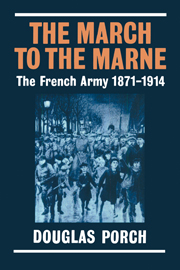Book contents
- Frontmatter
- Contents
- Dedication
- Preface
- 1 The army and the republic
- 2 The army and the nation
- 3 The high command
- 4 The Dreyfus affair
- 5 The Radical solution
- 6 The affaire des fiches
- 7 Anti-militarism and indiscipline
- 8 The colonial army
- 9 The army and the Nationalist Revival
- 10 The three-year law
- 11 The spirit of the offensive
- 12 The heavy artillery
- 13 Conclusion
- Appendix 1 War Ministers 1871–1914
- Appendix 2 Army corps areas
- Notes
- Select bibliography
- Index
7 - Anti-militarism and indiscipline
Published online by Cambridge University Press: 18 January 2010
- Frontmatter
- Contents
- Dedication
- Preface
- 1 The army and the republic
- 2 The army and the nation
- 3 The high command
- 4 The Dreyfus affair
- 5 The Radical solution
- 6 The affaire des fiches
- 7 Anti-militarism and indiscipline
- 8 The colonial army
- 9 The army and the Nationalist Revival
- 10 The three-year law
- 11 The spirit of the offensive
- 12 The heavy artillery
- 13 Conclusion
- Appendix 1 War Ministers 1871–1914
- Appendix 2 Army corps areas
- Notes
- Select bibliography
- Index
Summary
In the post-Dreyfus years 1906 marked a political turning point. The alliance of republican defence which bound Radicals and socialists with the cry ‘no enemies to our left’, began to unravel as the representatives of the working class called into question the sincerity of their bourgeois allies. The 1905 formation of the Section Française de Internationale Ouvrière, France's first unified socialist party, strengthened, at least temporarily, the position of the intransigent Guesdist wing. Jaures and friends submitted to the directives of the 1904 Amsterdam congress which forbade socialist collaboration with bourgeois governments. The revolutionary Left turned its back upon the reformist Left, the socialists upon their erstwhile Radical allies. This political divorce was celebrated with a festival of labour unrest. The 18 March 1906 Courrieres disaster, in which 1,100 miners perished, sparked an era of confrontation between the government and the militant Confédération générale du travail which witnessed a rocketing number of strikes. Into this minefield of labour relations stepped Georges Clemenceau, first as interior minister in the March 1906 Sarrier government and finally as prime minister from October of that year. Not a man known for his willingness to compromise, Clemenceau waded into a delicate situation, setting off explosions which increasingly wrenched the unions from France's body politic. As his friends dropped off on the Left, Clemenceau was forced to form his majority to the Right. The old Jacobin was transformed into a man of order, the revolutionary into Trance's first cop', the Dreyfusard into the enemy of the Left.
Clemenceau's wanderings toward the Right did little to improve his standing with the army.
Information
- Type
- Chapter
- Information
- The March to the MarneThe French Army 1871-1914, pp. 105 - 133Publisher: Cambridge University PressPrint publication year: 1981
